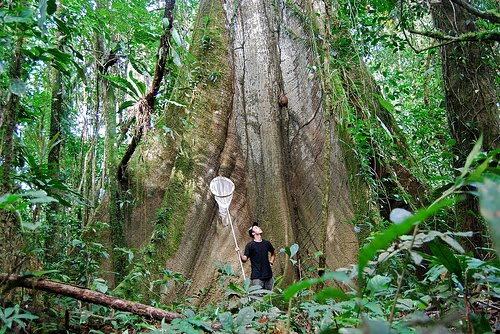La Selva itself is located on a 1,600 hectare reserve in the Sarapiqui canton of northwestern Costa Rica. To the south the property borders Braulio Carrillo National Park, which at 46,000 hectares forms the core conservation unit of the Cordillera Volcanica Central Biosphere Reserve. Together, these protected areas form a vast forested corridor that extends from low elevations at La Selva (ca. 30 – 100m) to over 2,900 meters at Volcan Barva in Braulio Carrillo. Four protected life zones provide refuge for a large number of plants and animals, including over 5,000 species of vascular plants, over 400 species of resident and migratory birds, diverse mammals and herpetofauna (reptiles and amphibians), and innumerable arthropods (bugs!).
 |
| Stone Bridge connects the two halves of the La Selva campus divided by Rio Puerto Viejo and provides access to the reserve. |
I’m here at La Selva for several reasons, all related to my graduate work at the University of Florida (UF) on the relationship between abundance and distribution in Neotropical butterflies. First, I hope to expand my consideration of scale. For my master’s degree at UF, I showed that there was no relationship between abundance and distribution among butterfly species in eastern Ecuador. As I’ve detailed in previous posts, I collected abundance measures at 5 sites there, covering a large portion of the eastern lowlands. However, I compared those abundance measures to those species’ global range-sizes, which almost always extended well beyond the region in which I gathered abundance data, and occasionally even throughout the entire Neotropical zone. Abundance data from Costa Rica will help to minimize the difference in scale between measures of abundance and distribution. In addition, there are a number of species that I expect to find here that are not present in South America, thereby increasing the number of species in my analyses. Finally, I hope to begin to prepare for a future trip to Peru that I plan for 2012-2013 in which I will be looking at the breadth of host-plant utilization among ithomiine butterflies, in an attempt to explain some of the patterns that I have observed. Learning their host plants is an obvious requisite for that, and I will spend some time here teaching myself plant identification.
I’ll be here for the next month or so, and I’ll have lots more to say about this place and what I’m doing here, stay tuned!


No comments:
Post a Comment